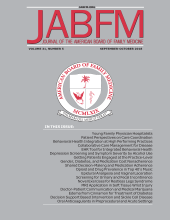In the May/June issue of Journal of the American Board of Family Medicine, Shultz and Holmstrom1 performed a systematic review of the literature investigating the effects of medical scribes on health care productivity, clinical quality, revenue, time efficiency, and patient–clinician interaction. We, at the University of California, San Francisco, Center for Excellence in Primary Care, applaud this research and agree that with the uptake of electronic health records in medical practices across the United States, much of the documentation and administrative burden has shifted to primary care providers. Using medical scribes to document visit notes and enter orders during the patient visit is a promising approach to improve the patient–clinician encounter in the current era of electronic health records.
Medical scribing can be embedded among other activities, and clinical staff members who perform the scribing function are not always called “scribes.” The literature review by Shultz and Holmstrom1 therefore excluded a few relevant publications that did not have the word scribe in the title or abstract. To this end, we found 4 additional studies that explored the effect of medical scribes in the clinical setting. One study used a team-based care approach that paired each clinician with 2 clinical assistants who consistently work together to care for their patients. The clinical assistants took responsibility for many of the patient care tasks, and scribed during the physician encounter. Anderson and Halley2 found an increase physician productivity that resulted in increased income to offset the costs of the additional personnel and also improved patient and staff satisfaction. Another peer-reviewed study investigated the use of practice partners in 2 academic health center practices. Practice partners were also paired with physicians in a 2:1 ratio and performed scribing and other administrative functions, including assisting patients with the checkout process. Reuben et al3 found that the use of practice partners led to a reduction in physician time spent before and after sessions, shorter geriatric visits, and higher patient satisfaction.
In addition, 2 non-peer-reviewed studies of the use of medical scribes in primary care settings found improvements in clinician satisfaction; an increase in the accuracy of chart notes and productivity4; a decrease in no-show rates, cycle time, and staff cost per relative value unit; an increase in gross net revenue per visit; and improvements in clinical quality measures.5 Based on the findings from Shultz and Holmstrom1 and the above additional literature, the variety of medical scribing and team documentation models can be divided in 2 broad categories: (1) the staff member accompanies the clinician during each patient visit and assists only with scribing and documentation, and (2) specially trained clinical staff members accompany each patient through a larger portion of the visit cycle to provide care services in addition to documentation during the clinician encounter. Each of these models has been associated with positive findings in the literature.
Despite these positive findings, we agree that the number of studies of either scribing model is small and rife with limitations. We support the call for additional, methodologically rigorous, and sufficiently powered research on the use of medical scribes in the primary care setting. In the meantime, practices interested in exploring their own scribing models can use several online resources, including the StepsForward module developed by Christine Sinsky, MD, and the American Medical Association (https://www.stepsforward.org/modules/team-documentation) and an evaluation toolkit available from our website (http://cepc.ucsf.edu/team-documentation-scribing).
Notes
The above letter was referred to the author of the article in question, who offers the following reply.







